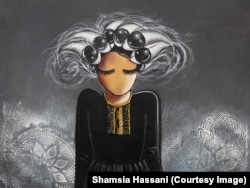Thirty-year-old Shamsia Hassani is widely recognized as Afghanistan’s first, if not only, female graffiti artist. Being a graffiti artist anywhere in the world is a challenge, but in war-torn Kabul, it carries its own unique difficulties.
An invitation to an Istanbul cartoon and street art festival allowed Hassani to share her pieces with a broader audience. The large mural she worked on for three days features a regular character of her work, a cool, fashionably dressed young woman playing an instrument.
“This character is always in my work with different compositions, and she has different messages and different colors,” Hassani explains. “She can use her musical instrument to talk to people, to speak louder and to get more attention, as she has no mouth.
“But this musical instrument gives her power to speak in society,” she adds “Her eyes are closed because usually, she has nothing good around her to see, she does not want to see anything around, and she cannot see her future. However, it does not mean she cannot see.”
Welcome respite in Istanbul
The opportunity to attend the Istanbul festival is welcomed, Hassani says, given the increasingly difficult environment in Afghanistan.
“Recently the situation is getting very bad, and I usually am feeling hopeless sometimes because I see that nothing has changed and I could not change anything, that’s very hopeless,” she said.
“Still, I am trying to work to give power to people and how they can stay strong in a society like Afghanistan,” she said.
Late to graffiti
Hassani has struggled in her pursuit of art. Born in Iran to Afghan parents who had fled the war in Afghanistan, she was prevented from studying art in Iran, she says, because of her Afghan heritage. Eventually, her parents moved back to Kabul so she could pursue her art studies at Kabul University, where she now teaches. Hassani’s love of graffiti came relatively late, however, thanks to an international initiative.
“I just started to make graffiti at a graffiti workshop in Kabul,” she said. “They brought a teacher from the U.K. by the name of Chu, and he teaches us how to do graffiti. It was a very good experience, and after that I was just trying to paint on walls, and I wanted to do graffiti.”
A luxury of time
Working on a mural for a few days at the Istanbul festival is a rare luxury for Hassani. Being a graffiti artist in one of the world’s most dangerous cities carries its own unique challenges, especially if you are a woman.
“I am really scared of public spaces; I am really scared for explosions happening all the time. Specifically, it’s difficult for women to do graffiti and street art because usually, people are not happy with women’s activity,” Hassani said.
“My family is very supportive, my parents and my husband, they always support me in my works. All the time I am careful,” she adds with a nervous laugh. “I usually work in Kabul, but usually on the small walls, not the big walls, because I cannot finish them. I need to run away as soon as I can.”
It’s not only the risk of bombs and hostility toward women artists, that Hassani faces. Artistic differences with the owners of the walls upon which she paints also can be a problem.
“I am trying to get permission, but sometimes it’s difficult. Usually the owner of the wall never gives me permission to paint something — fantasy like this” Hassani said, pointing to her mural. “They usually like me to paint some portrait or some landscape or something that they like. So that’s why it’s difficult to find a wall and location, as well.”
At the Istanbul festival she received a warm reception as she held a seminar, sharing her experiences with a full and appreciative audience that peppered her with questions. Hassani says the support and interest at the seminar is welcome because in Kabul, few dare to offer her public support.
“When I am working, sometimes I listen to people, and they usually use bad words,” she said. “But there are just a few people who say OK, it’s nice, or some people never say anything, they just pass by. But when I post my pictures on social media, I see a lot of support there. However, while working (outside) no support from people.”
Love, power of art
When asked what keeps her going, Hassani says it is her love of art and the power it has for good.
“I think I can introduce art to people in Afghanistan because we don’t have galleries and exhibitions, and it’s good way that I can just show them artwork,” Hassani said. “And I also think that I can change people’s minds with my artwork and sharing my ideas with people, that’s the thing I really like to do.”













